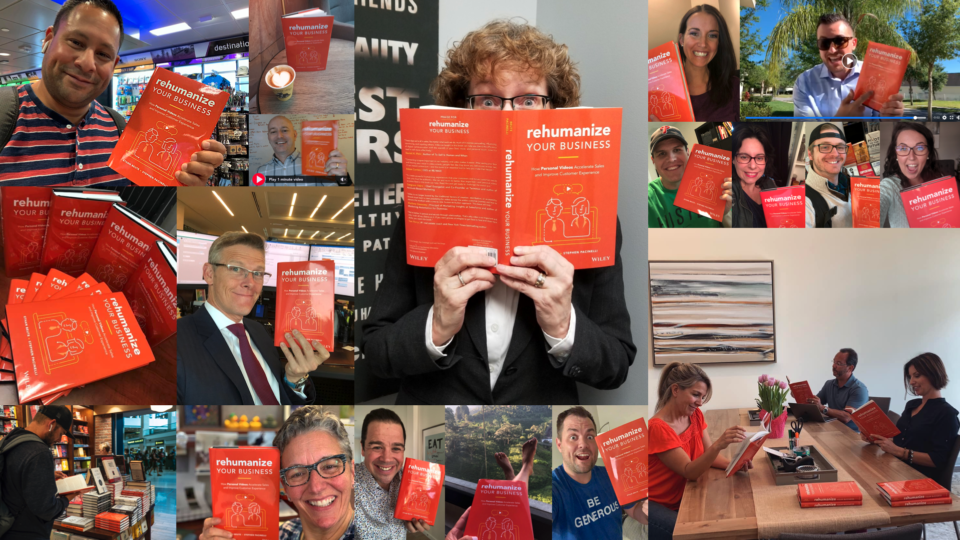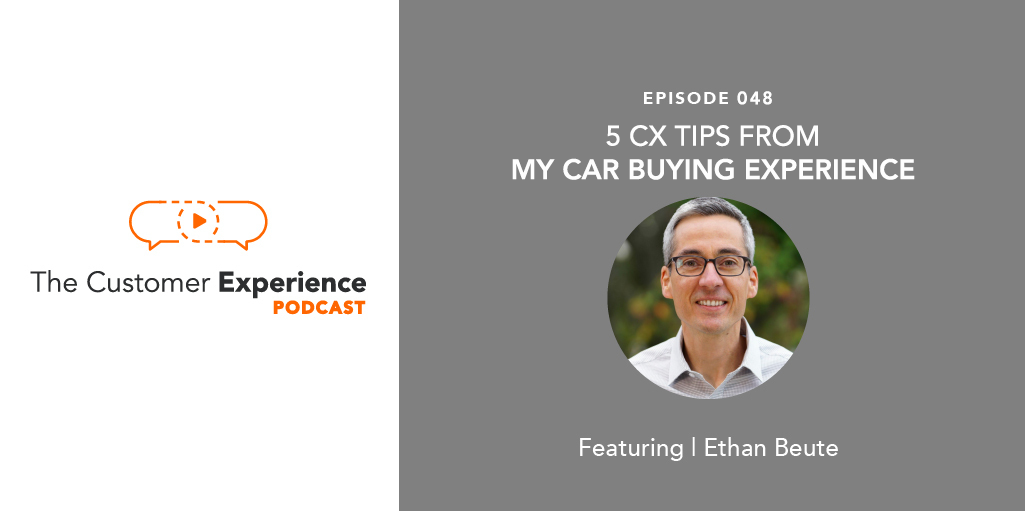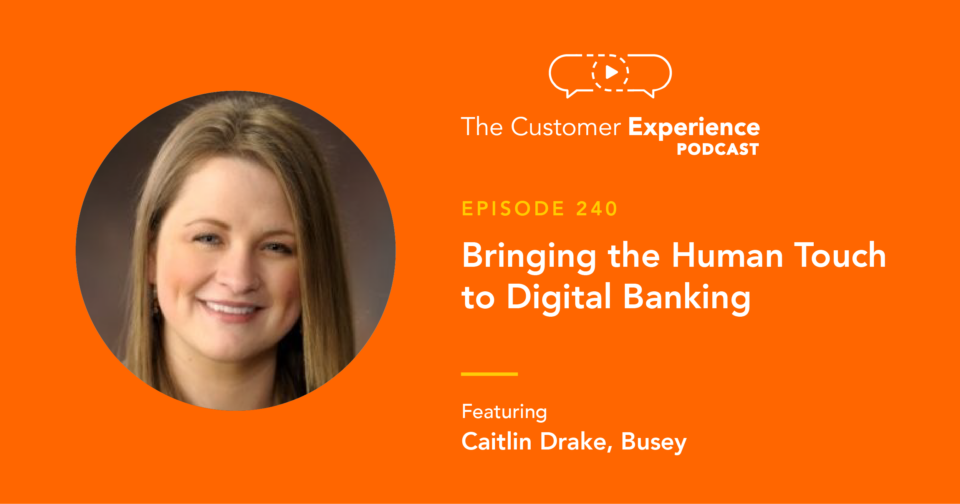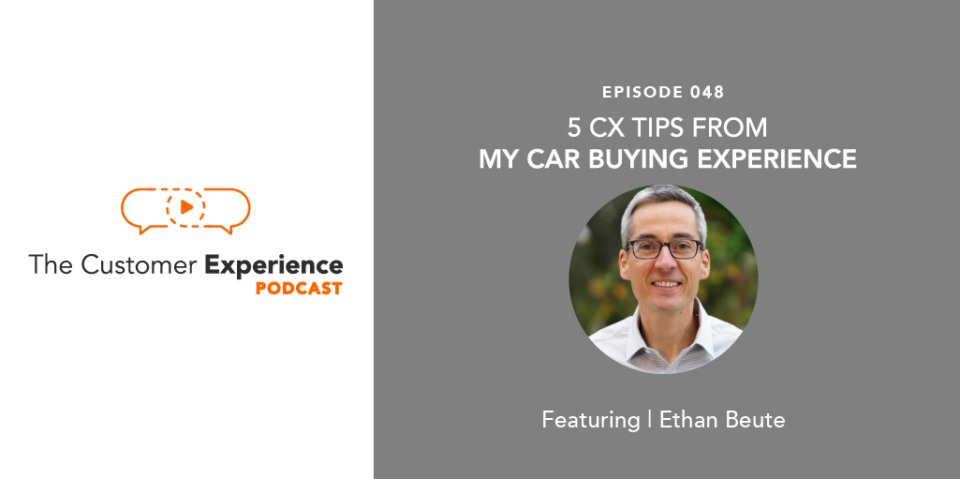
Listen to “48. 5 CX Tips from My Car Buying Experience w/ Ethan Beute” on Spreaker.
Apple Podcasts | Google Podcasts | Stitcher | Spotify
My wife and I recently undertook one of the more daunting and potentially peril-fraught consumer missions: buying a car.
And if there aren’t customer experience lessons in that process, I don’t know where else you’d look for them.
So, on this episode of The Customer Experience Podcast, I share five CX tips I picked up in this car buying experience.
If you’re not a regular listener to the show, know that every episode ends with the opportunity for a guest to mention a company they appreciate for the way they deliver for her or him as a customer.
Here, I’m doing something similar. I’m sharing customer experience insights that I gleaned … by being a customer.
5 CX Tips from My Car Buying Experience
Every episode gets a written overview with embedded video clips and an embedded episode recording right here in the blog.
You can also subscribe, rate, and review the podcast in your favorite player:
Of course, you can also hear my walkthrough of the car buying experience and the 5 CX tips learned along the way right here …
Listen to “48. 5 CX Tips from My Car Buying Experience w/ Ethan Beute” on Spreaker.
For Context: How We Buy Our Cars
We’re practical people. So when buying a car, we’re going for like-new. Our search was oriented toward a car that’s less than 2 years old with fewer than 20,000 miles. That way we don’t have to take that hit on depreciation when we drive it off the lot.
And we’re not really private party kinds of buyers, so we were looking at inventory held by car dealerships.
Every year, I enjoy studying the Consumer Reports car issue. On this car buying mission, we narrowed our options down to two choices that they recommend: the Volkswagen Golf Alltrack and the Toyota Prius.
Once we knew we were deciding between these two cars, we went online and started looking for vehicles. We searched on sites like Carmax and Carvana and inquired about several specific vehicles.
That brings me to my first takeaway from this experience …
#1 Focus on Timeliness and Responsiveness
As a marketing person, it’s always fun to see how companies respond to the various touchpoints they set up along the customer journey. So, I filled out several forms to inquire about specific vehicles I found in my online searches.
Several of the companies offering these cars for sale never got back to me at all!
Others only reached out with automated messages. They wouldn’t call or email me directly, even though I was an active buyer who raised my hand.
So, as you look at your own process, look at how timely and responsive you are to inbound inquiries and opportunities – in all of their forms.
No matter your product or service, you’re not just selling to a person, you’re selling to a window of opportunity. When someone inquires specifically about something you’re offering right now, you must respond to them in a timely manner. Because the competition is just a click away.
#2 Manage Your Customers Expectations
My wife and I had our eye on a Prius up in Denver.
We communicated back and forth with the seller. We spoke by phone, we swapped emails, and ultimately, we committed to buy this car.
He got together all of the final paperwork and we made an appointment to drive up to purchase the car. Everything was set. We were all-in on this opportunity.
But the day after he set the appointment, I got an email from our sales guy that contained just 3 words: “It sold. Sorry.”
When I called him to ask what happened, he said “We have 30 other salespeople on this lot. They need to eat, too.”
Talk about a failure to meet expectations! And failure to empathize with your customers.
I thought that since he set up the appointment, sent the calendar invite, and drew up and sent the final paperwork, that this was our car. All we had to do was drive up to Denver with the check in hand, sign a bunch of paperwork, and drive home with an incredibly reliable, insanely practical, and new-to-us car.
But the salesperson was operating from a completely different expectation – one he failed to communicate to us.
If he’d let us know that it could sell out from under us in the two days between setting the appointment and showing up in person, we’d have gone up there that day. Or put down some earnest money. Or whatever he wanted.
But the failure to manage our expectations left us extremely disappointed. Of course, he could have communicated more effectively, too.
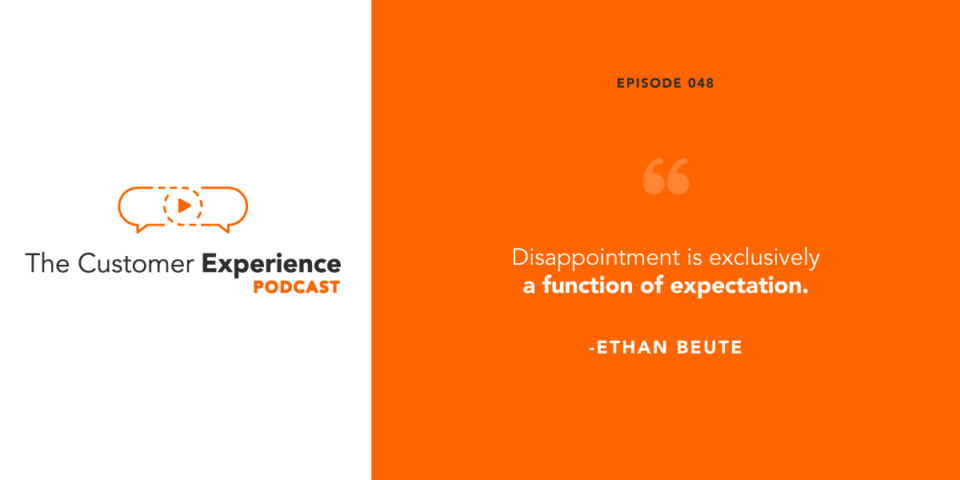
So, think about expectations that others might have at different points in their relationship with you.
Are you operating from the same expectations? Where have people been surprised or disappointed?
More communication and more specific communication are always better than less.
#3 Be Honest
Because this is a used car story, you probably won’t be surprised to hear that there was some dishonesty we encountered throughout the process.
But here’s a crazy story.
After the Prius fell through, my son and I went in to test drive an Alltrack we’d found online that was just a mile from my house.
I had already pressed them a little on the price and they had come down about $350.
It was the last day of the month, it was 6pm, and they were only open for a couple more hours.
I told my salesperson and his sales manager that I would go home, talk about it with my wife, sleep on it, and give them a decision in the morning.
Because it’s a key factor in the decision, I asked them both one more time to quote me the absolute best price they possibly could on that car.
The sales manager looked me in the eye and said “I need to make $200 on every used car sale. That’s where I am right now on this one, I have no room to move on the price of this car.”
I said, “That’s fine. I respect that. We’ll follow up with you in the morning.”
The manager headed back into his office. Two minutes later as I’m still chatting out front with my salesperson, the manager comes running back out:
“Hey, Ethan. I’ve got exciting news! It’s the last day of the month, and your salesperson has sold 9 cars so far this month. If he sells this 10th car, he gets a bonus. If I could give you $500 off right now, would you buy this car tonight?”
“Of course not,” I replied. “I told you I wasn’t buying this car tonight and you just told me you had no room to move on the price.”
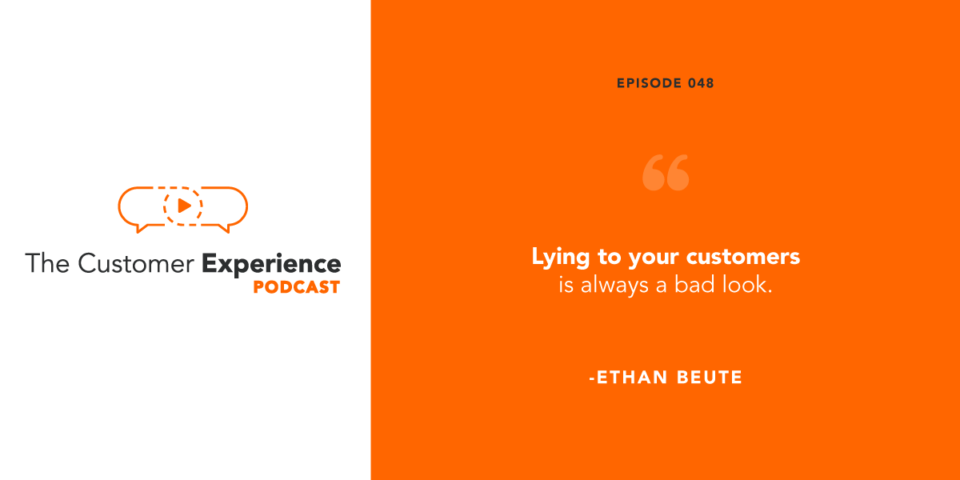
I couldn’t believe he lied right to my face.
Two minutes earlier, he had absolutely no room to move on price. But now, he wants to knock off $500 and give his guy a bonus. It was more weird and funny than it was offensive. But it was still offensive.
Even thought the car was in great shape, had low miles, was incredibly fun to drive, was priced as aggressively as any I’d found in a couple months of searching, and was located just a mile from my home, I knew I’d never buy that car – or any other car – from that dealership.
Those tactics are so old fashioned and silly. And I told this to my young salesperson. He’d done a great job communicating throughout the process and lost the deal through no fault of his own.
Bottom line: Lying to your customers is always a bad look.
#4 Make It Easy
Companies like Carmax and Carvana are so popular because they’ve identified the things that frustrate people throughout the car buying process. And they’ve eliminated many of these issues.
In fact, we ended up purchasing our car through Carmax.
We inquired about a hybrid displayed on their site and made an appointment to go check it out in person.
Here are a few of the things that that made our experience frictionless:
> When I made the appointment, they took the car off the website instantly. They reserved it for me. That’s very different from how things went with the Prius in Denver.
> They offer a 7-day return policy. The mileage didn’t even matter — they would give us all of our money back no matter what within 7 days if we were dissatisfied for any reason. We were purchasing from one of their stores north of Denver, but they were allowing us to make the return in Colorado Springs should we need or want to.
> They also offered a 90-day warranty.
> They paid to get us a new copy of the owner’s manual for the car since it was missing. They had an easy process for it already designed and easily communicated.
> And guess how long the whole process took? From test drive to driving home? 90 minutes. We walked in – and 90 minutes later we walked out with a car.
> Here’s the final touch. As we were signing the final paperwork, someone was touching up the interior and exterior of the car. Then as we walked out to the car, they had positioned it in a parking bay with a nice sign behind it and a giant yellow bow on the hood. Our salesperson asked for my phone, then snapped a few nice photos for us.
That was a nice little “surprise and delight” moment that built some social proof for them as we texted it to family and friends who wanted an update on our car buying process.
The whole experience was very well thought out. They eliminated anything that might cause buyer’s remorse and created a seamless experience that even had some special touches.
#5 Know That Values Matter
Ultimately, we made our purchase decision on moral and ethical grounds.
Now, not everyone thinks this way, but it’s becoming increasingly common for consumers to consider a company’s values.
We opted against the Alltrack for 2 key reasons:
> First, it only gets 22 miles to the gallon – half of the 44 mpg for the hybrid we purchased.
> Second, Volkswagen was recently caught in a diesel emissions cheating scandal. If you’re unfamiliar, here are overviews from the Wharton School of Business and from NPR. It cost the company billions of dollars – and its reputation.
At the end of the day, values do matter. Now more than ever, our purchasing decisions reflect our values. They say something about us to ourselves – and to others.
Hopefully these 5 takeaways help you think through the way you’re interacting with your customers to ensure you’re creating and delivering a truly great customer experience.
Get More From The Customer Experience Podcast
Where to Subscribe, Rate, and Review:
Hear More Short, “Self” Episodes Like This One:
- How NOT to Use LinkedIn Messaging for Prospecting
- Rehumanize Your Business by Building Relationships Through Video
- 3 Ways to Win with the SaaS Sales Method
Listen To Upcoming Guests Like:
- Vanessa Van Edwards (founder of Science of People, author of Captivate)
- Scott Barker (Head of Partnerships at Sales Hacker, Sales Evangelist at Outreach)
- William Ammerman (author of The Invisible Brand and digital media executive)
- Shep Hyken (author of several bestselling books, customer service and customer experience expert)
Improve Customer Experience With Video
Something many automotive sales professionals are doing when customers inquire about specific vehicles is recording and sending simple, personal videos. They put a face with the name, thank the prospective buyer, and guide people to the next step in the process. Some even do walk-and-talk videos with their smartphones to show the vehicle in a truly personal way.
No matter your role, your company, or your industry, you have opportunities across the entire customer lifecycle to add clearer communication, human connection, and higher conversion with casual, conversational video messages.
When used in the right spots, they’re far more effective than the plain, typed-out text that you overrely on today.
How do you do it? Which spots are the right spots? What do I say?
We tackle all these questions and more in Rehumanize Your Business, the first book written on this style of video communciation.
- Amazon #1 bestseller in Customer Relations, Business Communication, and Business Sales
- 800-CEO-READ/Porchlight Books #1 bestseller in its opening month of release
- Barnes & Noble bestseller in its opening week of release
